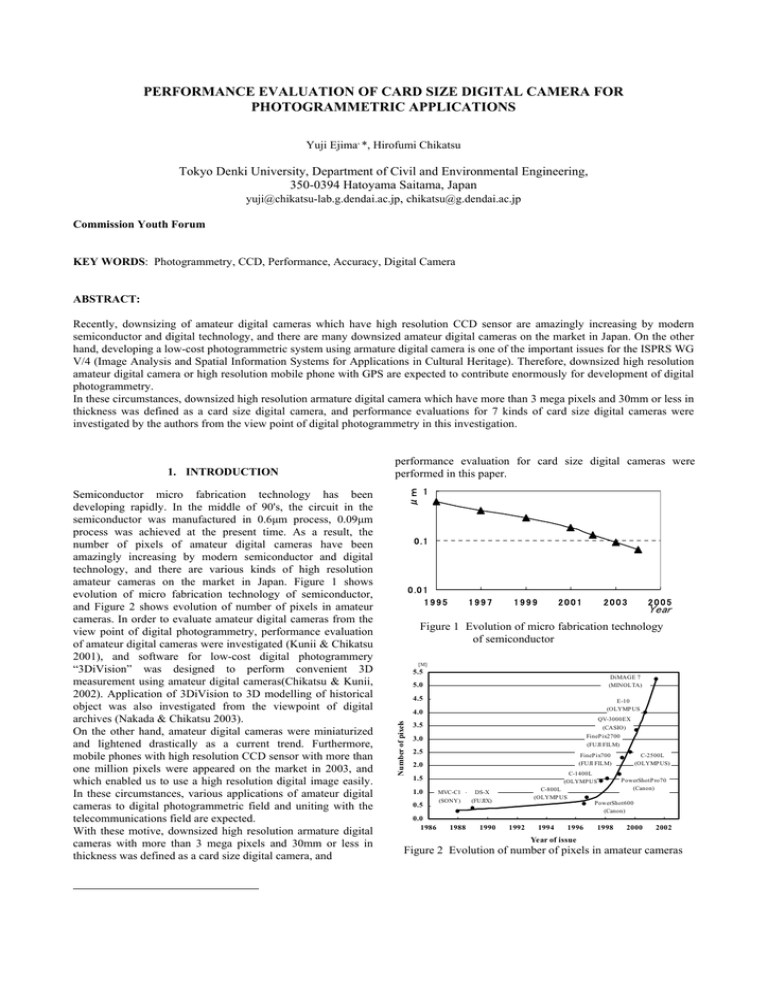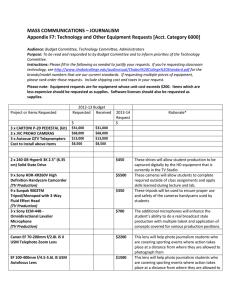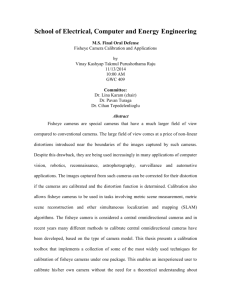PERFORMANCE EVALUATION OF CARD SIZE DIGITAL CAMERA FOR PHOTOGRAMMETRIC APPLICATIONS
advertisement

PERFORMANCE EVALUATION OF CARD SIZE DIGITAL CAMERA FOR PHOTOGRAMMETRIC APPLICATIONS Yuji Ejima, *, Hirofumi Chikatsu Tokyo Denki University, Department of Civil and Environmental Engineering, 350-0394 Hatoyama Saitama, Japan yuji@chikatsu-lab.g.dendai.ac.jp, chikatsu@g.dendai.ac.jp Commission Youth Forum KEY WORDS: Photogrammetry, CCD, Performance, Accuracy, Digital Camera ABSTRACT: Recently, downsizing of amateur digital cameras which have high resolution CCD sensor are amazingly increasing by modern semiconductor and digital technology, and there are many downsized amateur digital cameras on the market in Japan. On the other hand, developing a low-cost photogrammetric system using armature digital camera is one of the important issues for the ISPRS WG V/4 (Image Analysis and Spatial Information Systems for Applications in Cultural Heritage). Therefore, downsized high resolution amateur digital camera or high resolution mobile phone with GPS are expected to contribute enormously for development of digital photogrammetry. In these circumstances, downsized high resolution armature digital camera which have more than 3 mega pixels and 30mm or less in thickness was defined as a card size digital camera, and performance evaluations for 7 kinds of card size digital cameras were investigated by the authors from the view point of digital photogrammetry in this investigation. 1 μm Semiconductor micro fabrication technology has been developing rapidly. In the middle of 90's, the circuit in the semiconductor was manufactured in 0.6µm process, 0.09µm process was achieved at the present time. As a result, the number of pixels of amateur digital cameras have been amazingly increasing by modern semiconductor and digital technology, and there are various kinds of high resolution amateur cameras on the market in Japan. Figure 1 shows evolution of micro fabrication technology of semiconductor, and Figure 2 shows evolution of number of pixels in amateur cameras. In order to evaluate amateur digital cameras from the view point of digital photogrammetry, performance evaluation of amateur digital cameras were investigated (Kunii & Chikatsu 2001), and software for low-cost digital photogrammery “3DiVision” was designed to perform convenient 3D measurement using amateur digital cameras(Chikatsu & Kunii, 2002). Application of 3DiVision to 3D modelling of historical object was also investigated from the viewpoint of digital archives (Nakada & Chikatsu 2003). On the other hand, amateur digital cameras were miniaturized and lightened drastically as a current trend. Furthermore, mobile phones with high resolution CCD sensor with more than one million pixels were appeared on the market in 2003, and which enabled us to use a high resolution digital image easily. In these circumstances, various applications of amateur digital cameras to digital photogrammetric field and uniting with the telecommunications field are expected. With these motive, downsized high resolution armature digital cameras with more than 3 mega pixels and 30mm or less in thickness was defined as a card size digital camera, and performance evaluation for card size digital cameras were performed in this paper. 0 .1 0 .0 1 1995 1997 1999 2001 2003 2005 Year Figure 1 Evolution of micro fabrication technology of semiconductor [M] 5.5 DiMAGE 7 (MINOLTA) 5.0 4.5 E-10 (OLYMP US 4.0 Number of pixels 1. INTRODUCTION QV-3000EX (CASIO) 3.5 FineP ix2700 (FUJI FILM) 3.0 2.5 FineP ix700 (FUJI FILM) 2.0 C-1400L P owerShotP ro70 (OLYMP US (Canon) C-800L (OLYMP US P owerShot600 (Canon) 1.5 1.0 0.5 0.0 1986 MVC-C1 (SONY) 1988 DS-X (FUJIX) 1990 C-2500L (OLYMP US) 1992 1994 1996 1998 2000 2002 Year of issue Figure 2 Evolution of number of pixels in amateur cameras 2. PERFORMANCE EVALUATION OF CARD SIZE DIGITAL CAMERA 2.1 Experiments In order to estimate accuracy of card size digital cameras, experiments were performed using 7 kinds of card size digital cameras. Figure 3 shows these cameras and Table 1 shows the major components for these cameras. Stereo images were taken, and camera calibrations were performed by the resection method using 9 control points. After the camera calibration, accuracy was estimated using R.M.S.E. for 33 check points. Test target were made by the accuracy of ±0.01mm for plane coordinates and ±0.5mm for vertical. Figure 4 shows the test target. 9 out of the 42 points on test target were used for camera calibrations, and other 33 black points were used as check points. Stereo images for the test target were taken five times with each camera under the same condition (distance from the center of camera to test target, length of base line), and image coordinates for each point were given as the center of area gravity by image processing. Accuracy for 3D coordinates of check points was compared with space resection using 9 GCPs. The average accuracy for 3D coordinates of check points were investigated in this paper. DSC-T1 DSC-F77 DiMAGE Xi EX-Z3 DiMAGE Xt IXY DIGITAL30 OptioS 2.2 Evaluation of Lens Distortion In order to estimate lens distortion for card size digital cameras, three different lens distortion models shown in Table 2 were investigated. Model 0 means no correction for lens distortion, model 1, 2 consider only radial symmetric distortion, and model 3 considers both radial and tangential distortion (Fryer, 1986). Figure 5 shows the R.M.S.E. for 33 check points by each lens distortion models, and R.M.S.E. for the other amateur digital cameras with more than 3 mega pixels are shown together. It may be seen from the results that lens distortion for the armature digital cameras are improved by radial polynomial 3rd degrees distortion model (Model 1), and model 2 and model 3 do not show any further significant improvements compared with model1. Similarly, R.M.S.E. for some card size digital cameras are improved by model1. However, R.M.S.E for some card size digital cameras are improved remarkably by Model 3. It may be said that the reason are depend on some mechanical problems in downsizing and lightening process such as lens storage mechanism and multi-layer structural lens, and individual problem of the specific card size digital cameras. Therefore, it can be said that lens distortion for the card size digital cameras should be corrected by using radial and tangential model, instead of lens distortion for the armature digital cameras can be corrected sufficiently using radial polynomial 3rd degree model as usual. 2.3 Relation between image resolution and accuracy The relationship between the image resolution and accuracy is shown in Figure 6 and 7, and the results for armature digital cameras are shown together. Figure 6 shows the R.M.S.E for the both camera groups corrected by Model 1. Figure 7 shows the R.M.S.E. for armature digital cameras by Modle1, and R.M.S.E. for the card size digital cameras corrected by Model 3. It may be concluded from these figures that the significant accuracy are achieved in the case of digital card size cameras when lens distortion are corrected by model 3. Table2 Lens distortion models Figure 3 Card size digital cameras ○:Control Points ●:Check Points 20(mm) Model No Correction item 0 No correction. 1 Radial distortion 2 Radial distortion 3 360(mm) 360(mm) Figure 4 Test target Equation dx = k1r 2 x dy = k1r 2 y dx = k1r 2 x + k 2 r 4 y dy = k1r 2 y + k 2 r 4 y ( ) dx = k1r 2 x + k 2 r 2 + 2 x 2 + k3 2 xy Radial and tangential distortion dy = k r 2 y + k (r 2 + 2 y 2 ) + k 2 xy 1 3 2 Where, dx and dy : correction value,k1 ,k2 and k3 :distortion coefficient x and y : image coordinate, r 2 = x 2 + y 2 Table 1 Major components of the card size digital cameras Produ c e r Pro du c t N ame CASIO MIN O LTA MIN O LTA Can on PEN TAX SO N Y SO N Y EXILIM ZO O M EX- Z3 D iMAGE Xi D iMAGE Xt IXY D IGITAL 3 0 O ptio S c ybe r- sh ot D SC- F7 7 c ybe r- sh ot D SC- T1 N u mbe r of Pixe l (Me ga pixc e l) 3 .2 0 3 .2 0 3 .2 0 3 .2 0 3 .2 0 4 .0 0 5 .1 0 CCD Se n sor 1 / 2 .5 1 / 2 .7 1 / 2 .7 1 / 2 .7 1 / 2 .5 1 / 1 .8 1 / 2 .4 in c h in c h in c h in c h in c h in c h in c h Size (W× H × D ) 8 7 .0 × 5 7 .0 × 2 2 .9 8 4 .5 × 7 2 .0 × 2 0 .0 8 5 .5 × 6 7 .0 × 2 0 .0 8 5 .0 × 5 6 .0 × 2 3 .9 8 3 .0 × 5 2 .0 × 2 0 .0 9 2 .6 × 7 1 .0 × 2 7 .0 9 1 .0 × 6 0 .0 × 2 1 .0 mm mm mm mm mm mm mm We igh t 126g 130g 120g 165g 98g 152g 155g 2 .50 σz (mm) 2 .00 1 .50 ■:CP-900Z +:C-3030 ZOOM -:RDC-7 ◆:GC-X1 □:Fine Pix S1 Pro ▲:DSC560 ▲:DSC-F77 ◇:DSC-T1 ×:IXY DIGITAL30 ◆:DiMAGE Xi ●:DiMAGE Xt □:OptioS △:EX-Z3 1 .00 0 .50 0 .00 M od el 0 M od el 1 M ode l 2 M od el 3 a) Z accuracy 0.14 σx y( mm) 0.12 0.10 0.08 0.06 0.04 M o de l 0 M o de l 1 M o de l 3 M o de l 2 b) XY accuracy Figure 5 Accuracy by each lens distortion model. 0 .5 0 R .M.S .E.(mm) 0 .4 0 0 .3 0 Z accuracy 0 .2 0 XY accuracy 0 .1 0 0 .0 0 0 1 2 3 4 5 6 7 8 6 Nu mbe r o f P ixe ls (×1 0 ) Figure 6 Relationship between the image resolution and accuracy (Model1) Card size digital cameras ▲:DSC-F77 ◇:DSC-T1 ×:IXY DIGITAL30 ◆:DiMAGE Xi ●:DiMAGE Xt □:OptioS △:EX-Z3 Black points Z accuracy Gray points X-Y accuracy Amateur digital cameras * :Z accuracy 0 .5 0 - :X-Y accuracy R .M.S .E.(mm) 0 .4 0 0 .3 0 0 .2 0 0 .1 0 0 .0 0 0 1 2 3 4 5 6 7 6 Nu mbe r o f P ixe ls (×1 0 ) Figure 7 Relationship between the image resolution and accuracy (Model3) 8 3 PERFORMANCE EVALUATION BY OUTDOOR EXPERIMENT In order to evaluate more practical accuracy, experiment was performed at outdoor using following 4 card size digital cameras and armature digital camera (CP-900Z). 17 targets were set on the test field which shown in figure 8. Circled 9 points were used for camera calibration, and other 8 points were used as check points. 3D coordinates of each target are measured by the total station (Accuracy of distance is ±1mm, accuracy of angle is ±2″), and image coordinate were given as center of area gravity by image processing procedures. Stereo images were taken 5 times using the 5 cameras so that base-height ration (0.34) might become the same condition (distance from the center of camera to test field (H:23.617m), and base line(B:8.029m)). Figure 8 Test field Table 3 R.M.S.E for the check points Model 1 Product Name Accuracy (mm) σxy 2.3908 CP-900Z σz 9.6100 σxy 6.0880 DiMAGE Xt σz 7.7025 σxy 6.7182 OptioS σz 9.3898 σxy 3.5554 IXY30 σz 8.6083 σxy 7.7963 EX-Z3 σz 8.1479 ⎛H⎞ ⎟⎟σ p ⎝ f ⎠ σ xy = ⎜⎜ ⎛ H ⎞⎛ H ⎞ ⎟⎟⎜ ⎟σ p ⎝ f ⎠⎝ B ⎠ σ z = ⎜⎜ Model 3 (mm) 5.2041 8.3887 4.1435 8.8318 3.7829 7.3772 3.3958 7.4982 2.9354 10.1759 Theoretical value (mm) 2.2884 8.7258 2.8505 8.3848 2.8212 8.9131 3.0289 8.9091 2.8265 8.9297 (1) Where, H: altitude, f: focal length, B: base line σp:pointing accuracy Table3 shows R.M.S.E for 8 check points. Model 1 means the results which were corrected by radial polynomial 3rd degrees distortion model, model 3 means by radial and tangential model, theoretical values means computed values using Eqs. (1) as pointing accuracy for each camera was assumed 0.3 pixel. It may be said from this results that lens distortion for the card size digital cameras can be improved by radial and tangential distortion model as well as experiment on the above-mentioned, in particular XY accuracy is considerably improved by model 3. The accuracy for the card size digital cameras which were corrected by Modl 3 showed almost same accuracy compare with CP-900Z which were corrected by model 1. Furthermore, the accuracy for the card size digital cameras which were corrected by Modl 3 showed almost same accuracy compare with theoretical accuracy. Consequently, it can be concluded that card size digital cameras are ushering in photogrammetric fields as an essential tool, which have ability to promise convenient photogrammetry 4 CONCLUSIONS Performance evaluation of the card size digital cameras for digital photogrammetry were investigated. XY accuracy is considerably improved by radial and tangential distortion model (model 3), and lens distortion for the card size digital cameras can be improved by model 3. Nevertheless lens distortion for armature digital camera with more than 3 mega pixels can be improved by radial polynomial 3rd degree distortion model as usual. On the other hand, from the results of the relationship with accuracy and pixel numbers, it can be seen that accuracy for the card size digital cameras which were corrected by model 3 shows almost same value with high resolution armature digital cameras with more than 3 mega pixels and professional digital cameras with 6 mega pixels Furthermore, the accuracy for the card size digital cameras which were corrected by Model 3 showed almost same accuracy compare with CP-900Z which were corrected by model 1 and with theoretical accuracy. Consequently, it is expected that card size digital cameras are popularly used in photogrammetric fields as a essential tool which have ability to progress convenient photogrammetry. Reference from Other Literature: Y. KUNII and H. CHIKATSU, 2001, On the Application of 3 Million Consumer Pixel Camera to Digital Photogrammetry, Proceedings of SPIE (Videometrics VII), Vol.4309, pp.278-287 H. CHIKATSU and Y. KUNII, 2002, Performance Evaluation of Recent High Resolution Amateur Cameras and Application to Modeling of Historical Structure, International Archives of Photogrammetry and Remote Sensing, Vol.XXXIV, Part5, pp.337-341, Corfu R. NAKADA and H. CHIKATSU, 2003, Generating 3D Model of "Meguro Residence" using Digital Armature Camera, International Archives of Photogrammetry and Remote Sensing (CD-Rom), Vol.XXXIV-5/W10, ISSN 1682-1777, Vulpera Fryer J. G. and Brown D.C., 1986, Lens Distortion for CloseRange Photogrammetry, Photogrammetric Engineering and Remote Sensing, Vol.52, No.1, pp. 51-58.




